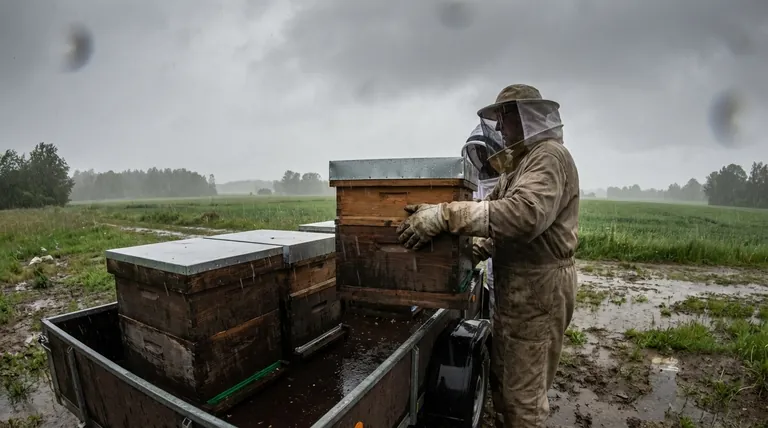In short, moving a hive in rain or winter is effective because these conditions keep the bees inside. When bees are naturally confined to the hive, they cannot fly back to their original location. This forces them to re-evaluate their surroundings and perform new orientation flights once the weather clears, effectively resetting their internal GPS to the new spot.
The core challenge of moving a beehive is overcoming the foragers' powerful homing instinct. Any successful relocation, whether by using bad weather or another method, depends on breaking their memory of the old location and forcing them to create a new one.

The Challenge of a Bee's Navigational Memory
The Forager's Internal GPS
Foraging honey bees possess an incredibly precise navigational system. They memorize the exact location of their hive entrance through a series of initial "orientation flights" when they first emerge.
From that point on, they will return to that exact spot with unwavering accuracy after every foraging trip. If you move the hive, even by a few feet, they will fly back to the empty space where it used to be.
The Problem of "Drifting"
This phenomenon is known as drifting. Bees that return to the old hive location become lost, confused, and are often unable to find their colony in its new spot.
This weakens the moved hive, as it constantly loses its experienced foraging workforce. In a severe case, a significant portion of the colony's foragers can be lost, jeopardizing its health and productivity.
Forcing a Navigational Reset
The Principle of Sequestration
The most common method to prevent drifting is sequestration, which means confining the bees to their hive. Beekeepers will often close the entrance with a screen for 48-72 hours after a move.
Being confined disrupts their normal flight patterns. When the entrance is finally opened, the bees recognize that something significant has changed and are triggered to perform new orientation flights to map the new location.
How Bad Weather Mimics Sequestration
Moving a hive during an extended period of rain or during the cold of winter serves the exact same purpose as manual sequestration. The bees are naturally confined.
Because they haven't been flying for a day or more, their first flight from the new location will be a cautious orientation flight. They will circle the hive, memorize local landmarks, and lock in the new position.
Understanding the Trade-offs
Unpredictability of Weather
Relying on weather is inherently unpredictable. A brief afternoon shower is not enough to force a reset; you need a prolonged period of at least a full day where flight is impossible.
Winter moves are highly effective because the colony is clustered and not flying, but this limits your moves to a specific season.
Stress and Overheating
Confining bees, whether manually or through weather, can be stressful. If you manually close a hive (sequestration), you must ensure there is adequate ventilation.
A sealed hive can quickly overheat, even on a mild day, which can be fatal to the colony. Using a screened entrance or a moving screen is critical.
Making the Right Choice for Your Move
- If you need to move a hive a short distance (under 3 miles): You must force reorientation. Moving during a multi-day storm or confining the bees for 48-72 hours are your most reliable options.
- If you are moving a hive a long distance (over 3 miles): Drifting is not a concern, as the old location is beyond their range. However, it is still best practice to move at night or in poor weather to ensure all foragers are inside the hive.
- If you need the most predictable result: Manually confining the bees with a screened entrance for two to three days is more reliable than waiting for the perfect weather window.
Ultimately, a successful hive move depends entirely on breaking the bees' attachment to their previous location.
Summary Table:
| Factor | Why It Works | Key Consideration |
|---|---|---|
| Rainy Weather | Bees are naturally confined, forcing new orientation flights when it clears. | Requires a prolonged period of rain (at least a full day). |
| Winter Weather | The colony is clustered and not flying, providing a natural confinement period. | Limited to the winter season; ensure the hive is well-insulated. |
| Manual Sequestration | Closing the hive entrance for 48-72 hours reliably disrupts flight patterns. | Critical to provide adequate ventilation to prevent overheating. |
Ensure a smooth and successful hive relocation for your apiary. Proper equipment is key to managing bee orientation and colony health during moves. HONESTBEE supplies commercial apiaries and beekeeping equipment distributors with the durable, wholesale-focused supplies needed for effective hive management. Contact our experts today to discuss your equipment needs and keep your colonies thriving.
Visual Guide

Related Products
- HONESTBEE Advanced Ergonomic Stainless Steel Hive Tool for Beekeeping
- HONESTBEE Professional Long Handled Hive Tool with Precision Cutting Blade
- Professional Dual-End Stainless Steel Hive Tool for Beekeeping
- Professional Grade Foldable Beehive Handles
- Professional Galvanized Hive Strap with Secure Locking Buckle for Beekeeping
People Also Ask
- How is a hive tool used for scraping and cleaning? Master Hive Maintenance for a Healthy Colony
- What are the basic tools for beekeeping? Essential Starter Kit for Safe & Successful Hive Management
- What is a hive tool and what are its uses? Master Your Hive Inspections with the Essential Beekeeper's Tool
- Why is it important to compare the progress of different hives? A Beekeeper's Key Diagnostic Tool
- What tools are used for cleaning frames? A Beekeeper's Simple 4-Tool Guide



















